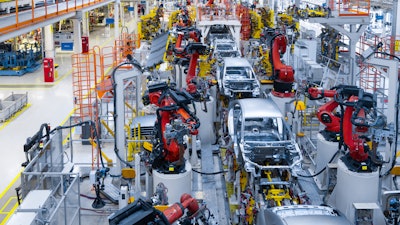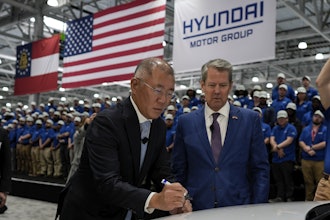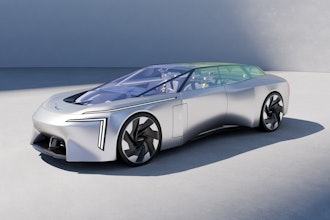
Lasers have come a long way since the automotive industry started using laser technology in its manufacturing processes. In 1973, Ford deployed an underbody laser welding system for its assembly line. In the 80s, lasers began being widely used for welding of gear parts and engine components. The 90s saw laser applications such as tailor-welded blanks and hydroformed parts.
Since then, the automotive industry has adopted lasers for a range of operations beyond welding. Common laser applications include cutting and drilling, marking for traceability, cleaning and texturing for surface preparation, and scanning for quality inspection.
In 2022, lasers are employed at every stage of the car manufacturing process, from design and development to final assembly. Volkswagen AG, for example, now uses more than 800 high-power lasers in its global assembly plants.
Laser technology offers important advantages for modern manufacturers. Let’s look at some of the most important ones.
Extreme Precision
Modern lasers are extremely precise and produce consistent quality even with heavy use.
Most errors come from part positioning variations, but today’s laser technology uses vision cameras to verify positioning and avoid errors. This provides accurate referencing of the part’s position in relation to the laser and eliminates errors.
Other laser systems work without cameras and instead counteract depth variations by using special optical configurations that improve the depth of focus. Newer systems can tolerate up to +/- 3mm during processing, making it possible to produce consistent quality even when there are significant depth variations.
There are many automotive applications that benefit from high laser precision. Many car manufacturers need to remove the e-coating from specific sections on parts to prepare them for welding. Laser cleaning is the ideal solution for these applications, as it can remove coatings and contaminants from small, localized areas. Other manufacturers need to cut small patterns on materials like carbon fiber plates. Micro laser cutting can cut circular patterns as small as 300 microns without a problem.
Quick Changeovers
Auto manufacturers know that time spent on changeover is necessary, but every second it takes impacts productivity and efficiency. Streamlining and reducing changeover time can increase output and reduce costs.
Adopting Single-Minute Exchange of Die (SMED) strategies has reduced changeover from hours to less than 10 minutes for many manufacturers. With lasers, however, system changeovers are nearly instantaneous, sometimes taking just under a second.
Because laser changeovers occur using software, adjustments can be fully automated and precise. The resulting gains in speed make changeovers seamless and dramatically reduce downtime where no parts are being produced.
Faster Processing Speeds
With the current demands in the automotive and EV industry, manufacturers are increasingly willing to invest in faster technologies to be able to meet their production throughput objectives.
Laser processing speed can make a significant difference for automotive manufacturers. In most material processing applications, doubling down on the laser power means doubling the processing speed. For example, a 200W laser can clean a surface almost twice as fast as a 100W laser. The same applies when cutting plastics, where the laser power can be doubled to achieve a twofold increase in cutting speed.
Manufacturers willing to invest in more powerful laser technologies can dramatically reduce processing time and improve throughput. Today, laser manufacturers are continually producing more and more powerful lasers.
At the same time, the software driving lasers is evolving, which is significantly improving laser cleaning and cutting scalability.
Accelerating the "Greenification" of the Auto Industry
Gartner forecasts six million electric cars will be shipped in 2022 at a growth rate of 34.4% from 2022. While the marketplace for EVs is growing, consumers are also looking more closely at the practices manufacturers are deploying when building their products.
Because lasers operate without consumables, they can significantly reduce waste and replace non-eco-friendly technologies. Lasers can help manufacturers reduce or eliminate their reliance on consumables like ink, labels, chemicals, masking tape, and abrasive media. Due to the non-contact nature of the process, there is also no tool wear —a significant source of waste.
The automotive industry has made significant strides in the “greening” of its manufacturing process. However, there’s still improvement to be made. Investments in laser technology can help OEMs continue their evolution.
Managing Compact Manufacturing Spaces
Manufacturing space is expensive, so companies want to be as economical as possible when building out production lines. When automotive manufacturers add a new machine to an existing production line, they might also have access to limited floor space and have to "squeeze in" anything they add.
Compact machines are the key to addressing this issue.
Advancements in laser technology have evolved to a point where new laser machines can operate efficiently in compact sizes. This is ideal for compact manufacturing lines with reduced floor-space requirements.
Fiber laser technology, for example, uses an optical fiber instead of a large chamber as required by other types of lasers.
Not only are laser systems compact, but they are typically installed in enclosures that have a much lower footprint than what they replace, such as chemical baths, dedicated sandblasting rooms, or complete masking operations with several operators.
Increasing Flexibility
Lasers are some of the most flexible tools because of their versatility and how the technology can be adapted to meet the specific needs of automotive manufacturers.
Lasers can handle the diversity of components, materials, and processes used in the automotive industry. They are used to mark, etch, texture, cut, clean, drill, and weld. Since laser parameters can be updated on the fly, the same laser can perform multiple operations. Some devices can perform laser marking, cleaning, texturing, hardening, and cutting with a simple program update that takes less than one second.
Lasers are used to meet complex surface needs. Ablation depth and surface texture can be controlled, and ablation patterns can be changed with a minimum of effort. This flexibility can eliminate multiple processing steps or the need for multiple machines.
Lasers can process any surface where light can go, so they can process parts whose geometry would make some areas inaccessible with conventional tools. For example, lasers can clean the bottom of cavities at a high speed compared to other processes.
Lasers deliver just the right amount of energy when processing a surface. For example, laser cleaning removes contaminants like oxides and coatings without damaging the substrate. This is very important to preserve surface integrity.
The Future of Lasers in Automotive Manufacturing
The ability to produce high-quality components with high efficiency, speed, and flexibility and produce significant cost savings using lasers have driven the industry towards ever greater adoption of laser technology.
The laser market in manufacturing continues to grow at a rapid pace. Analysts forecast a growth rate of 11.4% (CAGR) and expenditures of $30.3 billion by 2028.
Advancements in laser technology have already made a significant impact on the automotive industry and will only continue to grow and produce greater gains.
---
Keven Tremblay has been an electrical and automation technician for more than 6 years and is now a technical sales specialist at Laserax to present clients with the best laser solutions. His expertise in PLC programming and electrical design as well as with vision systems allow him to better evaluate clients' needs and offer them adapted industrial automated solutions.























